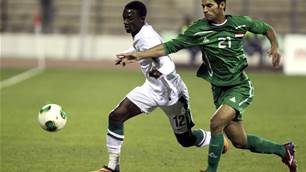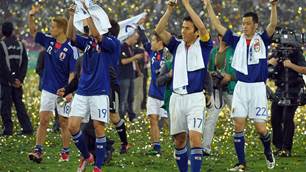The Kingdom of Saudi Arabia is the undoubted king of the Asian Cup.
Since its first tournament appearance in 1984, it has appeared in the final on five out of six occasions, winning three titles. Its group stage exit in 2004 was therefore a surprising blemish. In fact, it hasn’t won the title since beating hosts UAE in the 1996 final. This trophy-less run seems to be more than a mere blemish though, with Saudi Arabia appearing more and more like Asian football’s declining dynasty.
After bursting onto the scene with victories in the 1984 and 1988 Asian Cups – the first two continental tournaments it entered – Saudi Arabia established itself as arguably Asia’s foremost power firstly with victory in 1989’s FIFA U17 World Championship and then an appearance in the second round of the 1994 World Cup. Though it lost the 1992 Asian Cup final to Japan, the 1996 trophy consolidated the Saudis’ status as continental top dogs.
This success was bred locally, with Saudi Arabia’s rich economy and stable politics providing a prosperous platform for the development of the game. As the number one sport in the country, the Saudi league has become a strong domestic competition, built on not only the financial might of the local oil barons and the excellent infrastructure the economy has allowed, but also the continued development of and reliance on the nation’s local players.
With excellent wages, an inward-looking media and fanatical support, administrators and supporters regarded the domestic league during this golden period as the ideal basis for international success. No Saudi Arabian player in the successful 1994 campaign played outside his native country, indicating the high level of quality in the Saudi league.
Since then however, Saudi Arabia has fared less well. Though it finished runner-up in the 2000 Asian Cup, signs appeared that its international competitiveness was on the wane. In the 1999 Confederations Cup, the side leaked eight goals to Brazil, a tally that was repeated three years later but on the much larger World Cup stage against Germany. The round one exit in the last Asian Cup showed the Saudis’ Asian invincibility had been lost, as they finished bottom of their group, below even the mighty Turkmenistan. Since 1994, the Saudis’ World Cup record has also been dismal, with draws against South Africa and Tunisia their only return.
The fall from power is linked to the increasing globalisation of football in the late 1990s and early this century, epitomised by Arsenal’s French-bred success. Saudi Arabia sadly missed the bus.
No members of its 1994 side played overseas because the Saudi government had in fact banned them in order to protect their domestic competition. While the Saudi league was good enough to provide one of the top 16 nations at the World Cup in 1994, the concentration of the best players in the top leagues of Europe since then has meant the Saudis’ backwards approach has them lagging behind the rest of the world.
Although the government lifted its official ban on its players moving overseas in 1998, Saudi legend Sami Al Jaber was still refused a transfer to England’s Wolverhampton by his club in 2000. To this day, the insular Saudi football administration show little encouragement to the Saudi players in moves abroad.
The result has been that while Saudi Arabia continues to qualify for major tournaments, it can no longer match the world’s very best sides because its players do not get regular match practice against top-class footballers.
Even now, while the professionally run, well-resourced Saudi league can provide a team that soundly beats the likes of India and Yemen in qualifying, when it comes to full-strength, well-prepared sides like Japan and Australia, the Saudis have increasingly shown they can’t compete.
“The [Saudi] clubs don’t want to give [their players] what they deserve,” says former international Al Jaber. “But if Saudi Arabia wants to have good players in the future then they have to let them go.”
While this factor has muzzled their former dominance of Asia, that doesn’t mean they should be fully written off for this Asian Cup. Though they are paired with one of the tournament favourites in South Korea, and needed a penalty and a late goal to beat Bahrain in the recent Gulf Cup, they should progress to stage two.
Their capable side is led by four players. Goalkeeper Mabrouk Zaid is rated as one of Asia’s top goalkeepers, having learned his trade deputising for legend Mohamed Al-Deayea. In front of him, defender and Star Man Hamad Al-Montashari is a leader, while the midfield is bossed by the strong, aggressive Mohammed Noor.
In attack, all eyes will be on Yasser Al-Qahtani. The 24-year-old set a domestic transfer deal record when he moved to the club he supported as a boy, Al Hilal, in 2005 in exchange for close to $12 million.
What may hinder the Saudis is their recent change of coach. After losing to hosts UAE in the semi-finals of the Gulf Cup to a last minute goal, the Saudi football association sacked Marcos Paqueta. New man Helio Dos Anjos has had less than four months to ready his troops, and with no background in the Saudi game, may struggle to get the best out of his players.
FourFourTwo verdict
The Saudis will struggle to reach the semi-finals unless they can overcome South Korea on matchday one.
After bursting onto the scene with victories in the 1984 and 1988 Asian Cups – the first two continental tournaments it entered – Saudi Arabia established itself as arguably Asia’s foremost power firstly with victory in 1989’s FIFA U17 World Championship and then an appearance in the second round of the 1994 World Cup. Though it lost the 1992 Asian Cup final to Japan, the 1996 trophy consolidated the Saudis’ status as continental top dogs.
This success was bred locally, with Saudi Arabia’s rich economy and stable politics providing a prosperous platform for the development of the game. As the number one sport in the country, the Saudi league has become a strong domestic competition, built on not only the financial might of the local oil barons and the excellent infrastructure the economy has allowed, but also the continued development of and reliance on the nation’s local players.
With excellent wages, an inward-looking media and fanatical support, administrators and supporters regarded the domestic league during this golden period as the ideal basis for international success. No Saudi Arabian player in the successful 1994 campaign played outside his native country, indicating the high level of quality in the Saudi league.
Since then however, Saudi Arabia has fared less well. Though it finished runner-up in the 2000 Asian Cup, signs appeared that its international competitiveness was on the wane. In the 1999 Confederations Cup, the side leaked eight goals to Brazil, a tally that was repeated three years later but on the much larger World Cup stage against Germany. The round one exit in the last Asian Cup showed the Saudis’ Asian invincibility had been lost, as they finished bottom of their group, below even the mighty Turkmenistan. Since 1994, the Saudis’ World Cup record has also been dismal, with draws against South Africa and Tunisia their only return.
The fall from power is linked to the increasing globalisation of football in the late 1990s and early this century, epitomised by Arsenal’s French-bred success. Saudi Arabia sadly missed the bus.
No members of its 1994 side played overseas because the Saudi government had in fact banned them in order to protect their domestic competition. While the Saudi league was good enough to provide one of the top 16 nations at the World Cup in 1994, the concentration of the best players in the top leagues of Europe since then has meant the Saudis’ backwards approach has them lagging behind the rest of the world.
Although the government lifted its official ban on its players moving overseas in 1998, Saudi legend Sami Al Jaber was still refused a transfer to England’s Wolverhampton by his club in 2000. To this day, the insular Saudi football administration show little encouragement to the Saudi players in moves abroad.
The result has been that while Saudi Arabia continues to qualify for major tournaments, it can no longer match the world’s very best sides because its players do not get regular match practice against top-class footballers.
Even now, while the professionally run, well-resourced Saudi league can provide a team that soundly beats the likes of India and Yemen in qualifying, when it comes to full-strength, well-prepared sides like Japan and Australia, the Saudis have increasingly shown they can’t compete.
“The [Saudi] clubs don’t want to give [their players] what they deserve,” says former international Al Jaber. “But if Saudi Arabia wants to have good players in the future then they have to let them go.”
While this factor has muzzled their former dominance of Asia, that doesn’t mean they should be fully written off for this Asian Cup. Though they are paired with one of the tournament favourites in South Korea, and needed a penalty and a late goal to beat Bahrain in the recent Gulf Cup, they should progress to stage two.
Their capable side is led by four players. Goalkeeper Mabrouk Zaid is rated as one of Asia’s top goalkeepers, having learned his trade deputising for legend Mohamed Al-Deayea. In front of him, defender and Star Man Hamad Al-Montashari is a leader, while the midfield is bossed by the strong, aggressive Mohammed Noor.
In attack, all eyes will be on Yasser Al-Qahtani. The 24-year-old set a domestic transfer deal record when he moved to the club he supported as a boy, Al Hilal, in 2005 in exchange for close to $12 million.
What may hinder the Saudis is their recent change of coach. After losing to hosts UAE in the semi-finals of the Gulf Cup to a last minute goal, the Saudi football association sacked Marcos Paqueta. New man Helio Dos Anjos has had less than four months to ready his troops, and with no background in the Saudi game, may struggle to get the best out of his players.
FourFourTwo verdict
The Saudis will struggle to reach the semi-finals unless they can overcome South Korea on matchday one.
Related Articles

Asian Cup Qualifying: Trio make it to Australia

Saudi Arabia, UAE firm for 2015 Asian Cup













